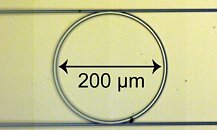Raevenlord
News Editor
- Joined
- Aug 12, 2016
- Messages
- 3,755 (1.20/day)
- Location
- Portugal
| System Name | The Ryzening |
|---|---|
| Processor | AMD Ryzen 9 5900X |
| Motherboard | MSI X570 MAG TOMAHAWK |
| Cooling | Lian Li Galahad 360mm AIO |
| Memory | 32 GB G.Skill Trident Z F4-3733 (4x 8 GB) |
| Video Card(s) | Gigabyte RTX 3070 Ti |
| Storage | Boot: Transcend MTE220S 2TB, Kintson A2000 1TB, Seagate Firewolf Pro 14 TB |
| Display(s) | Acer Nitro VG270UP (1440p 144 Hz IPS) |
| Case | Lian Li O11DX Dynamic White |
| Audio Device(s) | iFi Audio Zen DAC |
| Power Supply | Seasonic Focus+ 750 W |
| Mouse | Cooler Master Masterkeys Lite L |
| Keyboard | Cooler Master Masterkeys Lite L |
| Software | Windows 10 x64 |
A joint team of researchers from Australia's Monash, Swinburne and RMIT universities have developed a new interpretation of the current fiber optic infrastructure - one that managed to deliver a 44.2 Tbps throughput via existing optical lines. The achievement, which delivers speeds in excess of 1 million times greater than the average home users' internet speed (50.2 megabits per second for the US), paves the way for upgrades on the existing fiber optic network that hugely decrease costs compared to the need to implement a wholly new infrastructure.
The feat was achieved using a microcomb - a device which is able to replace a number of the currently in-use lasers for the transmission of information. A microcomb is an optical device that generates very sharp and equidistant frequency lines in a tiny microphotonic chip, and it allows researchers to make use of not only the presence of light - as it's done with the usual lasers found in optical equipment - but the lack of light as well, in what researchers call "dark" pulses of light. While nowadays no user would ever need transmission speeds in the order of the 44.2 Tbps achieved by the researchers, advancement in processing, communication technologies, and supercomputing will eventually make use of these - and even higher - throughputs, which is why it's so important that this technology has been developed on top of existing infrastructure.


View at TechPowerUp Main Site
The feat was achieved using a microcomb - a device which is able to replace a number of the currently in-use lasers for the transmission of information. A microcomb is an optical device that generates very sharp and equidistant frequency lines in a tiny microphotonic chip, and it allows researchers to make use of not only the presence of light - as it's done with the usual lasers found in optical equipment - but the lack of light as well, in what researchers call "dark" pulses of light. While nowadays no user would ever need transmission speeds in the order of the 44.2 Tbps achieved by the researchers, advancement in processing, communication technologies, and supercomputing will eventually make use of these - and even higher - throughputs, which is why it's so important that this technology has been developed on top of existing infrastructure.


View at TechPowerUp Main Site





